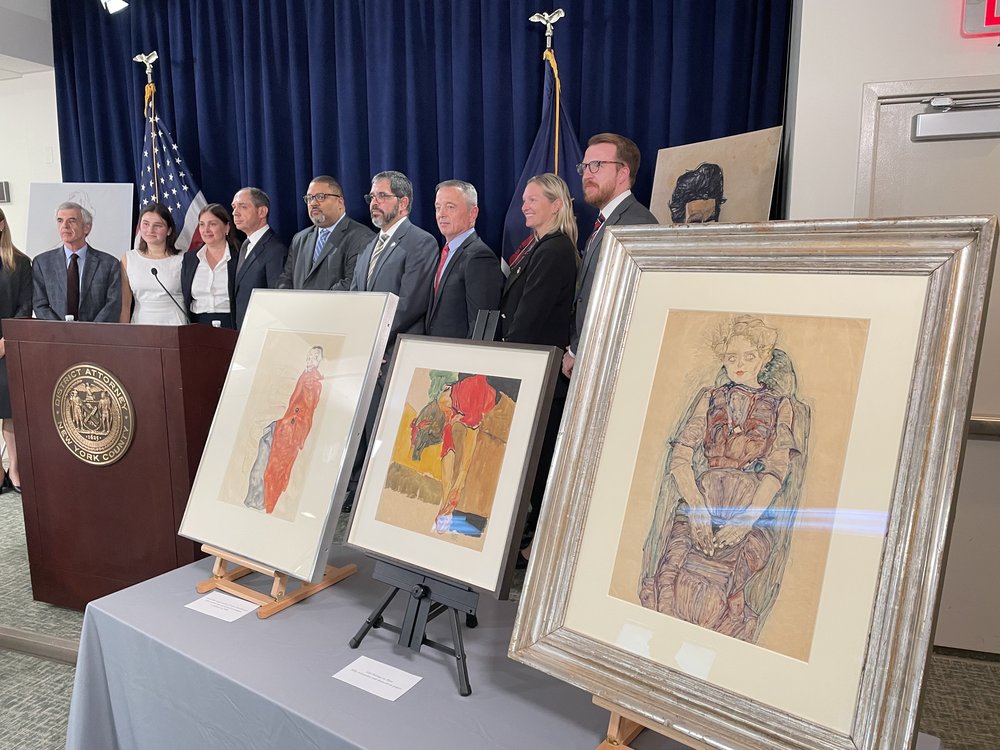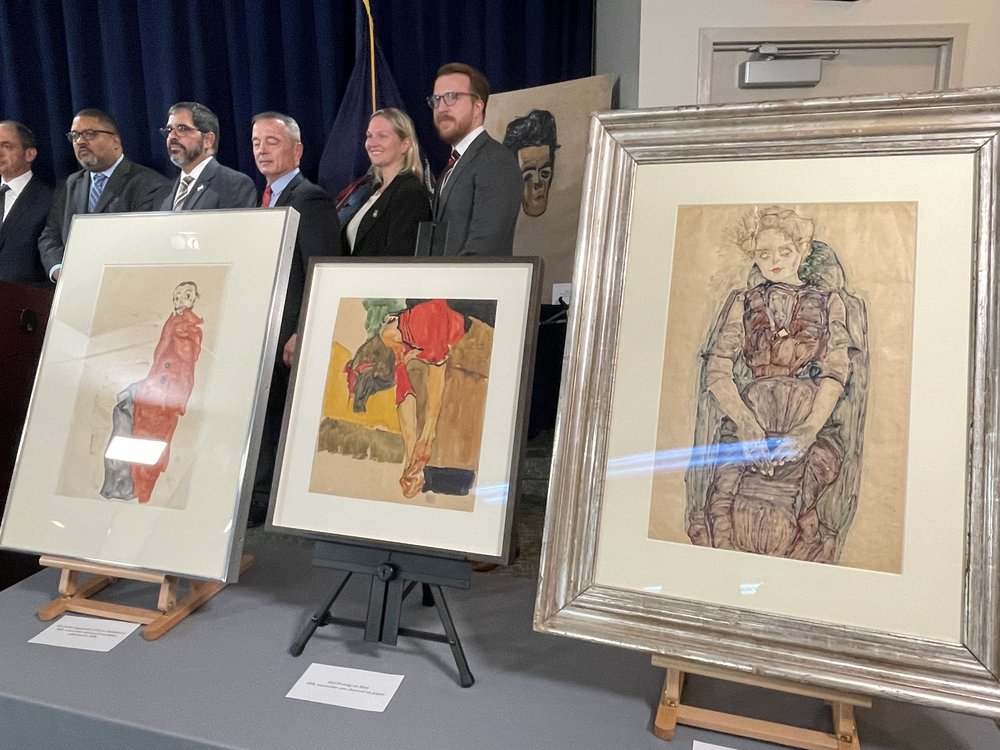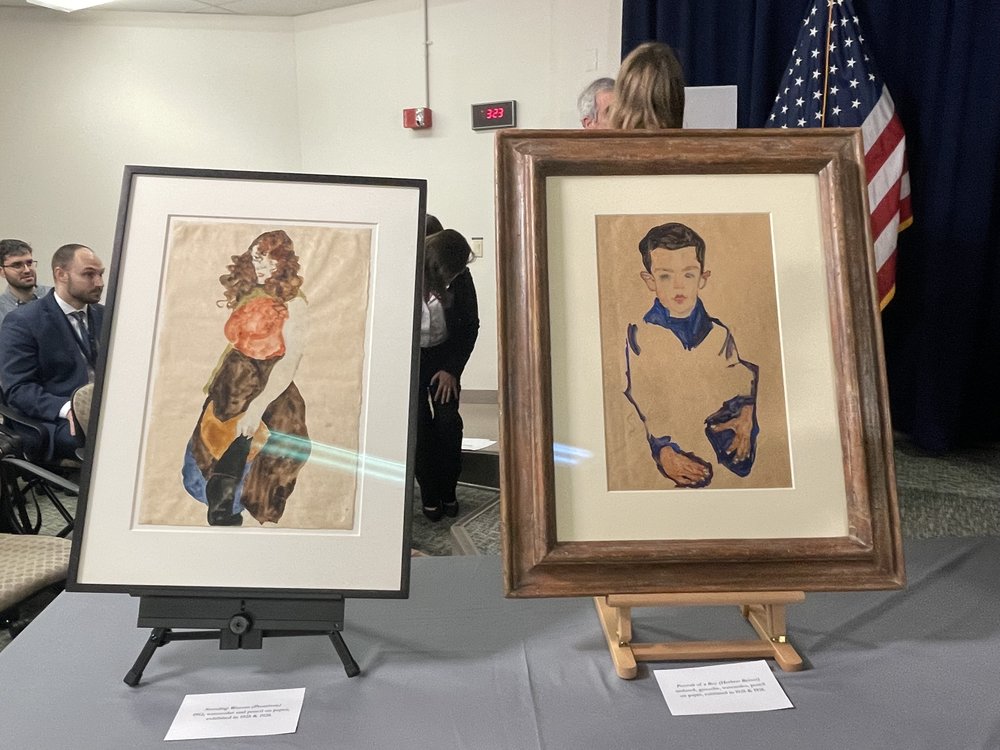7 artworks, seized by Nazis, returned to descendants in NY
Sept. 20, 2023, 8:57 p.m.
The works by Egon Schiele belonged to a Jewish collector killed in the Holocaust. They eventually found their way to collections in New York City.

An epic legal affair involving artworks looted by the Nazi regime drew to a close on Wednesday in Lower Manhattan, where the works were handed over to the descendants of a Jewish collector who was murdered during the Holocaust.
The artworks, by the renowned Austrian artist Egon Schiele, were forcibly taken from Fritz Grünbaum, a Jewish cabaret performer who was killed in 1941 at Dachau concentration camp, according to descendants of the artist as well as a pivotal court ruling.
The pieces ended up, over the span of many decades, at various museums, including the Museum of Modern Art and the Morgan Library, both in New York, eventually becoming the subject of a series of federal and state court cases.
“I don’t think it’s an overstatement. Today is historic and groundbreaking,” said Manhattan District Attorney Alvin Bragg, at whose office the handover ceremony took place and which helped orchestrate the return. “We are returning these beautiful works, these drawings, to their rightful home. To their family.”

The ceremony brought together federal prosecutors with descendants of Grünbaum, including Timothy M. Reif, a judge in the U.S. Court of International Trade, who said the occasion was “bittersweet” and asked attendees to “remember all those who lost their lives in the Holocaust.”
“We ask you to remember Fritz’s career as a cabaret artist, librettist, comedian, film and radio star,” said Reif, noting that Grünbaum remained a vocal critic of the Nazi regime until his death.
“He did not mince his words,” said Reif.

Descendants have fought for decades to retrieve the artworks that Grünbaum had carefully assembled. Raymond Dowd, a lawyer for Grünbaum's descendants, said the turning point in the legal proceedings came with a ruling in State Supreme Court, accepting that Grünbaum had not voluntarily sold his collection.
“They put him in a concentration camp then forced him to sign a power of attorney that forced him to liquidate all his property and give all the proceeds to the Nazis,” said Dowd. “So if that's not theft, what is?”
Bragg’s office had jurisdiction in the case in part because some of the works passed through the hands of the late Manhattan art dealer Otto Kallir, whom prosecutors said in a press release had bought the works for his gallery, Galerie St. Etienne, in 1956 “with no provenance whatsoever.”

According to the release, “Kallir himself knew the artworks had belonged to Fritz Grünbaum because Kallir had seen the artworks in Fritz Grünbaum’s Vienna apartment when Kallir had them displayed for an exhibition at Kallir’s Neue Gallery in Vienna in 1928.” Kallir’s granddaughter Jane Kallir, who currently serves as co-director of Galerie St. Etienne, said she could not comment on pending litigation.
Reif said the artworks will be auctioned later this year in order to raise funds for a newly formed organization, the Grünbaum Fischer Foundation, which provides scholarships for young musicians. One of the works by Schiele, “I Love Antithesis,” previously owned by the Ronald Lauder Collection, is valued at $2.75 million, according to a release from the Manhattan D.A.’s office, while the two works from the MoMA collection are valued at $1.5 million and $1 million each.

The Museum of Modern Art did not immediately comment on the restitution of the Grünbaum artworks but states on its website that it adheres to the American Association of Museums (AAM)’s Guidelines Concerning the Unlawful Appropriation of Objects During the Nazi Era, from 2001.
According to Erin Thompson, a professor of art crime at John Jay College, “MoMA has tried to be thorough and transparent with all the works they've researched.”
Thompson said museums were increasingly under pressure to vet the provenance of artworks in ways they previously didn’t have to.
“It used to be only art that was directly stolen: Nazis bust down your door and steal it off your walls,” Thompson said. “What we're now arguing about these days is the idea of a coerced sale.”
The returned works were:
- “I Love Antithesis,” from the Ronald Lauder Collection, valued at $2.75 million;
- “Standing Woman” from the MoMA, valued at $1.5 million;
- “Girl Putting on Shoe” from MoMa, valued at $1 million;
- “Self Portrait,” from the Morgan Library, valued at $1 million;
- “Portrait of the Artist’s Wife, Edith,” SBMA, valued at $1 million;
- “Portrait of a Boy,” the Vally Sabarsky Trust, valued at $780,000;
- “Seated Woman,” the Vally Sabarsky Trust, valued at $1.5 million.